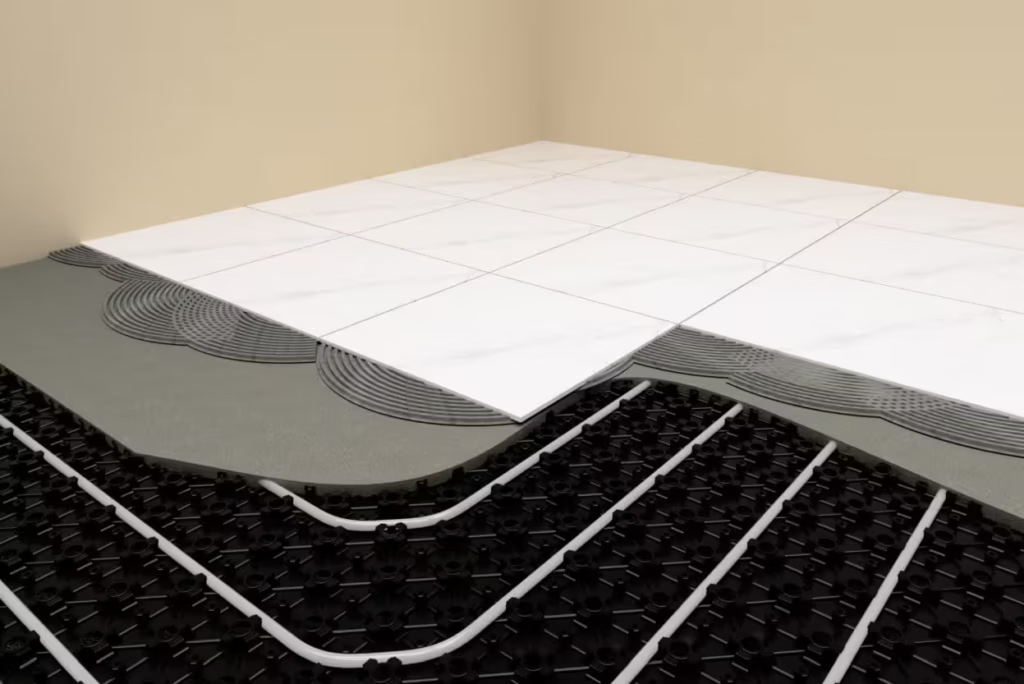As the nights draw in and the temperatures drop, you might be thinking about all the ways you could keep your house as warm and cosy as possible this winter. So, in this expert guide we’ll explore some of our top tips on how to keep the cold at bay. You’ll discover:
- Some instant ways to improve the warmth of your home
- The ideal indoor temperatures and how to maintain them
- The importance of insulation in the fabrication of a property
- Whether updating your heating system is a good idea
- How improving your home’s energy efficiency can also save you money
What quick steps can I take to feel warmer this winter?
If there’s a part of your home that remains stubbornly cold during the winter months and you’re looking for some instant ways to help warm it up, there are a few simple remedies which could prove invaluable.
- Seal existing drafts
It’s always a good idea to check your home’s windows and doors for drafts. If you feel cold air coming through your window, you can use sealant or caulking to seal up any existing gaps around the window frame. Hanging heavy curtains or blinds over windows can also make a huge difference. For draughty doors, positioning draught excluders at the bottoms are a great way to prevent cold air from entering a space.
- Maximize sunlight
A really simple way to raise indoor temperatures is by making sure you leave blinds or curtains open on sunny days to let in the warmth of natural sunlight – even on cold days, the sun can produce a surprising level of heat. Close them again once the sun sets to trap the heat inside.
- Consider space heaters
A space heater can quickly warm up small, particularly cold rooms but it’s important to only use them when the room is in use to avoid wasting energy. Electric blankets are also a good way to stay warm in a cold room but again, should only be used in short bursts. For bathrooms, heated towel rails are a brilliant way to introduce a new element of warmth to a space.
- Consider your floor finishes
Stone or tiled floors can feel very cold on a winter morning, so consider adding thick rugs to rooms featuring this floor type. For longer-term impact, you may also want to consider installing carpeting throughout a property to provide extra insulation and warmth underfoot.
- Keep unused rooms closed
For rooms in your home that you’re not currently using, make sure you close their doors. This will allow the heat to concentrate in those spaces where warmth is needed.
What’s the best temperature for a house?
Official health guidelines propose that U.K houses should be kept at a minimum of 18°C over the winter months but on the coldest days of the year, you’ll probably be more comfortable at a slightly higher indoor temperature of around 20 or 21°C.
Using a Smart Thermostat to control your heating system provides greater energy efficiency and temperature accuracy throughout a property. Warmup’s range of Smart heating controls allow you to enjoy energy-saving automated heat schedules at the temperature and timing of your choosing and are great to use in multi-zone heat set-ups too. Zoned heating means separating your home’s heating system into different ‘zones’ so that you can heat specific areas independently to each other, ensuring that you are not unnecessarily heating unoccupied spaces and helping to bring even greater savings. Find out more about the benefits of a multi-zone heating system in our in-depth guide .

How important is insulation in keeping a house warm?
In short, very. A well-insulated house prevents cold outdoor temperatures from seriously affecting its indoor temperature, so you’ll be that much warmer during the colder months of the year.
Good quality insulation should be installed throughout a property: within its walls and ceilings, floors and roof. Insulation reduces heat loss, trapping the warmth produced by your heating system inside the space which in turn, means that your heating won’t have to work as hard to raise temperatures. Without insulation, heat can escape very quickly, making it harder to keep your house warm and forcing you to use more energy and spend more money on your heating bills.
Insulation is recommended for use with all Warmup heating systems. Read our expert article to discover more about installing floor insulation.

Should I consider updating my heating system?
If you’re thinking about renovating your home, then updating its heating system is a great idea to ensure you’ll be as warm as possible for years to come. While central heating systems remain a popular heating method for flats and houses, they are not the most efficient or sustainable technology available. Radiator-based systems used with gas-fed boilers will require flow temperatures of anywhere from 60 – 70°C to maintain a room’s ideal comfort temperature of 20°C. This kind of inefficiency may result in higher energy bills, not to mention very high carbon emissions.
Warmup’s range of electric and water floor heating systems utilise radiant heat technology to warm the objects and people in a space directly, as opposed to central heating which just focuses on heating the air of a space. This process requires less energy whilst achieving the same feeling of warmth with lower operating temperatures required – helping to reduce energy use in a typical home by up to 35%.
You can learn more the differences between radiators and floor heating systems in our informative guide.
Is a water or electric floor heating system simpler to install?
If you’re interested in installing a new heating system in just one or two rooms of your home to improve its comfort levels, then an electric floor heater would be a great idea. Electric underfloor heating systems are quick to install and won’t raise floor heights – making them ideal to use in a bathroom or kitchen to work in tandem alongside an existing heating system in the rest of the property. Read our dedicated blog post about using underfloor heating alongside central heating to find out everything you need to know.
Water floor heating systems are best to install as the primary heating solution in larger home refurbishments or new-build projects. While these systems will take longer to install than an electric heater, as they operate at much lower temperatures than radiator-based systems they can improve heat source efficiency and assist in even bigger long-term savings.

Can I prevent frost or snow build-up on my roof or in my garden?
Yes, you can. With Warmup’s Snowmelting and Dec-Icing solutions you can rest assured that your roof, driveway, patio and gutters won’t be affected by wintry conditions.
Will improving my home’s energy performance save me money?
Improving your home’s level of warmth and comfort through all the tips we’ve explored – from sealing draughts to installing good quality insulation to controlling your heating with Smart controls to fitting a more energy efficient heating system – can also help you save substantial amounts of money on your bills.
The increased efficiency of underfloor heating results in lower long-term running costs than other heating methods. Water floor heating systems are also fully compatible with more sustainable ground and air-source heat pumps: using a Warmup water UFH system with a heat pump and Smart Thermostat can potentially save you over £600 a year on your energy bills and reduce the carbon emissions of your home by 1900 kgCO2.
Considering purchasing a new floor heating system? Get a free instant quote using our innovative online tool to find the best system to keep your home warm and cosy all winter long.




![Thumbnail [200x250]](/wp-content/uploads/Electric-Category-Page-Image.jpg)
![Thumbnail [200x250]](/wp-content/uploads/Hydronic-Category-Page-Image-1.jpg)
![Thumbnail [200x250]](/wp-content/uploads/6iE-Projects.jpg)